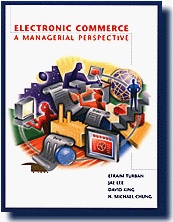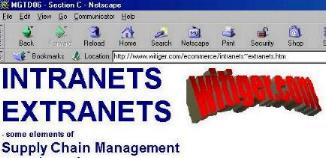| Wi | Ti | Ge | R |
|
MGTC44H3S |
 |
A 3rd year undergraduate course in the Division of Management, University of Toronto at Scarborough |
changes
were last made to this web page 2004 Dec 01
| Section A | Section B. | Section C. | Section D. | Section E. | Section F. | Section G. |
| . | The purpose
of this section is to introduce the student to the important of the Supply
Chain in International Business. Upon completion of this section, students
will be able to
|
"The success of a Global Manufacturing Strategy depends on four key factors 1. Manufacturing Compatibility
1. Manufacturing Compatibility cost minimization strategies - AKA trying to save money2. Manufacturing Configuration three basic configurations
"the linking or integration of activities into a unified system" 4. and Control" "... one aspect of control is the organizational structure" org charts
|
| Global Manufacturing
Strategy
Plant Location Strategies "Once MNEs determine that they will engage in FDI to supply foreign markets, they need to determine which countries to invest in and where within each specific country" text page 633 Textbook discusses General Motors choice of Thailand over the Philippines text notes "... there are
more auto suppliers..."
Attracting large MNEs to
invest is a bit like a country winning the Olympics - a very contentious
issue and raises many questions - some having to do with ethics.
Plant Location strategies is not a frequent consideration for Canadians in international business since our medium and large sized companies are more involved in resource extraction compared to manufacturing consumer goods.Global Manufacturing Strategy Layout Planning Strategies Text discusses Samsonite using the manufacturing technique of autonomous cells - which has also been used to great success by Japanese auto manufacturing companies in Japan, and to some small extent in North America. |
We [MGTC44] will discuss
some of the material in the text re: Intranets but in addition, the professor
will ask you to note some additional information below.
text says page 636
These exact percentages are
not so important - keep in mind one thing: in 2004, a reasonable
number of large size companies have corporate intranets, and many medium
sized companies are also learning the advantages of intranets, but still
only a small portion of SME's actually use extranets for supply chain management.
Extranets remain primarily a tool used by large sized companies.
"The real attraction of the Internet in the global supply chain management is that it not only helps automate and speed up internal processes in a company through the intranet but also spreads efficiency gains to the business systems of its customers and suppliers" |

Intranets and Extranets
|
go here to download the
ppt for Chpt 7
http://www.prenhall.com/divisions/bp/app/turban/cw/ppt/ Applications of Intranet
page
244- Turban Text
|

|
Information that is most often included in Intranets (this list comes from some notes in the Turban text on page 244 - additional points added in by WTGR)
International Business Reports for Corporate Intranets |
 |
http://www.witiger.com/ecommerce/intranets~extranets.htm
This is a Unit on Intranets and Extranets which is mostly used for e-commerce classes - however since many medium and large sized companies involved in international business have online situation, the use of Intranets and Extranets has become a part of "doing International Business" |
| . | CRM is a part of Supply
Chain Management.
Why? Because in a Market Oriented company -customers voting with their wallets, lead the direction of what products will be successful with particular FABs. The process of satisfying the customer leads to taking information about that relationship, and using it to affect production and delivery of the product. WTGR |
| Basics of CRM
"Customer Relationship Management (CRM) is developing into a major element of corporate strategy for many organisations. CRM, also known by other terms such as relationship marketing and customer management, is concerned with the creation, development and enhancement of individualised customer relationships with carefully targeted customers and customer groups resulting in maximizing their total customer life-time value....Narrow functionally-based traditional marketing is being replaced by a new form of cross functional marketing - CRM.... the focus is shifting from customer acquisition to customer retention" Why is time and money spent on CRM worthwhile, Payne notes "Research shows that a 5% points increase in customer retention yields a profit, in net present value terms, of between 20% and 125%" http://www.ittoolbox.com/peer/AP_website.htm
CRM for Dummies
"...why the sudden talk about
CRM?... With a general slowdown of the global economy companies are finding
it hard to get going....Gone are the days where you had a technological
edge over your archrival. With new and affordable technologies your competitor
is just a matter of days behind you in terms of product launch. So what
are you left with as a key-differentiating factor? ...customers need to
be looked at more seriously than ever before ... information is the key
to success. Information about the customer made available to the person
coming in contact with the customer can go a long way not only in clinching
the deal but also creating a very good relationship with the customer for
future business...
WTGR - does this mean you torture yourself to satisfy every single customer as best you can? Answer, no. You use various software tools and information tracking methods to determine which customers spend the most money on particular products, and you then focus on them
WTGR - in the past companies relied on sales people with good personal contacts and networking skills to build up good will with customers and create CLV - Customer Lifetime Value - problem was, when these people left the organization, all these contacts went with them (in fact many good salespeople are often headhunted to obtain new accounts). These situation became one of the weakness of organizational information structure - that being the point that people possessed information, not institutions. CRM is an attempt to build "institutional knowledge" regardless of the individual salespeople's personal contacts and information.
|
.
.
KAISEN
see www.witiger.com/internationalbusiness/kaizen.htm
| TQM and Kaizen are mentioned
briefly in the text - we value these discussions so we have expanded on
this. In addition; these two concepts are based on the fact that consideration
of the customer is more and more important; therefore we will take a brief
space to talk about relationship building with the customer - AKA
C.R.M.
FYI - CRM is increasingly more and more important when you consider the international customer base of many consumer product companies. |
Supplier Networks
Inventory management
FTZs - Foreign Trade Zones
Transportation Networks
(the fourth P - Place,
in "The 4P's)
| .Key
Points for Understanding |
The environments within
which international business is carried out in 2004 and beyond, are increasingly
competitive.
Therefore one of the key things for companies in the "new new" economy is to focus on the people in the company, and the customers they serve - ergo, Human Resource Management has become a "big issue" for international business. WTGR |
| Human
Resource Mgmnt Human
|

|
| Human
Resource Mgmnt Human
|
.
|
|
|
CONTACTIMAIN PAGE I NEWS GALLERY IE-BIZ SHORTCUTS I INT'L BIZ SHORTCUTS IMKTG&BUSINESS I TEACHING SCHEDULE IMISTAKES ITEXTS USED IIMAGESIRANKI |
| . |